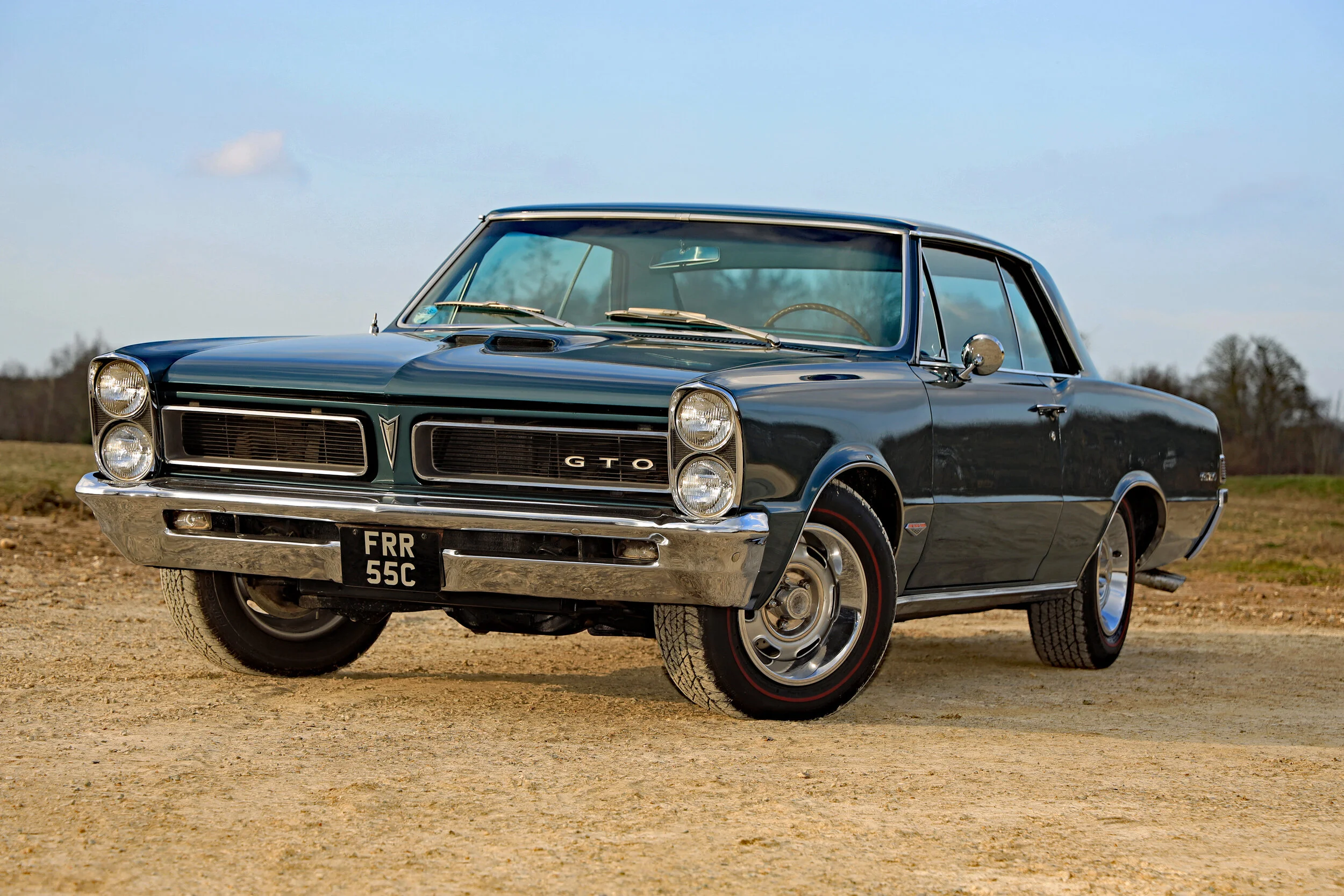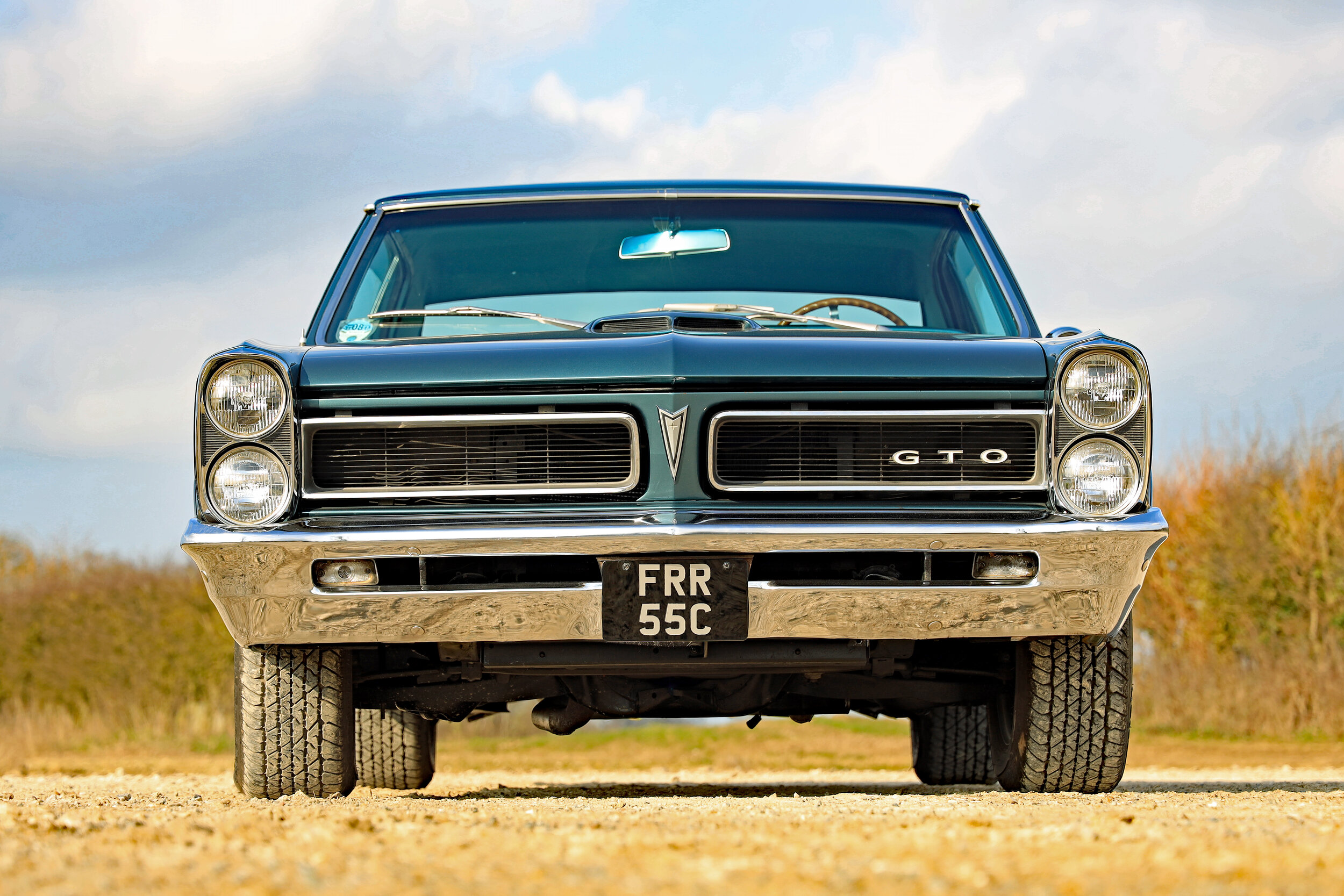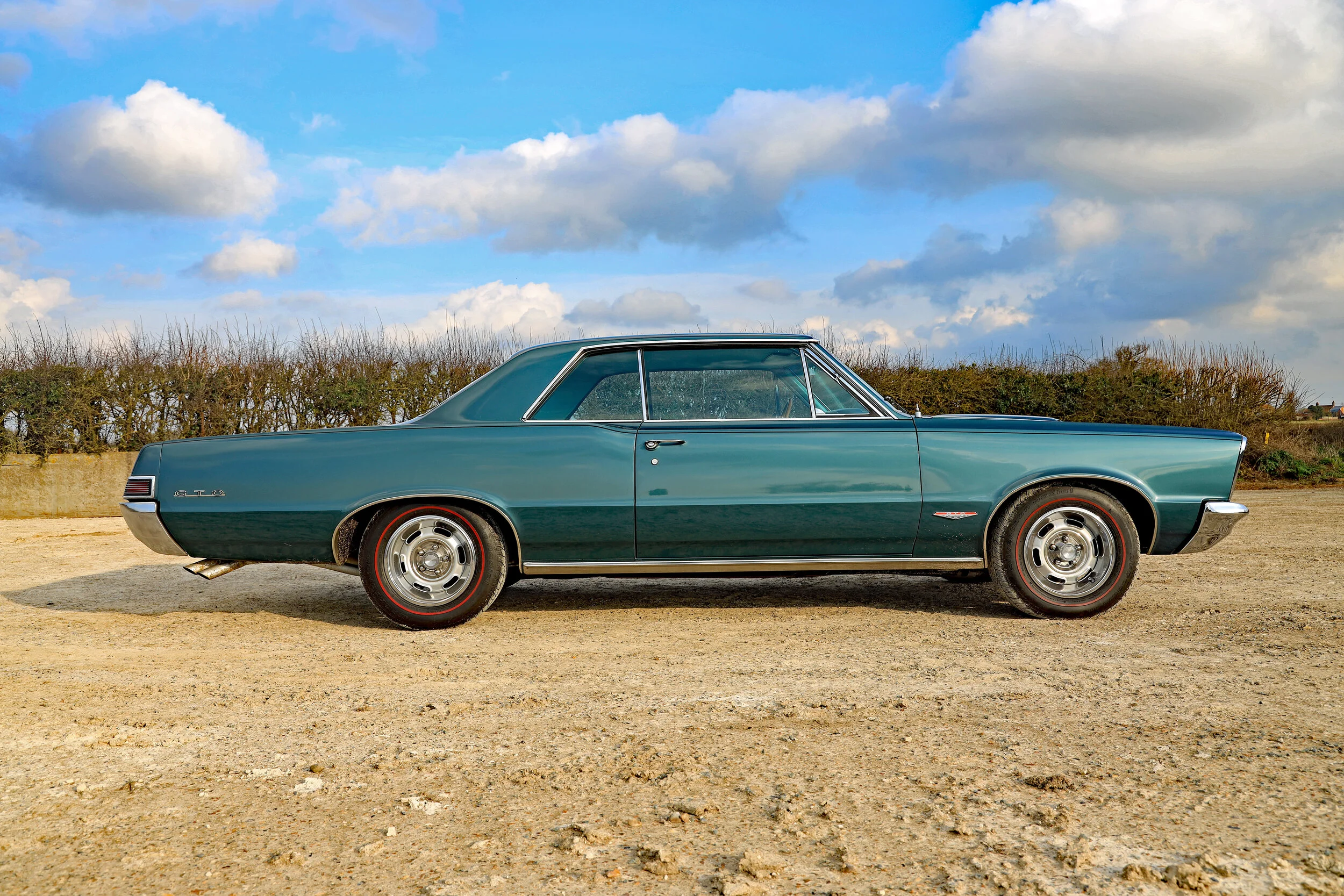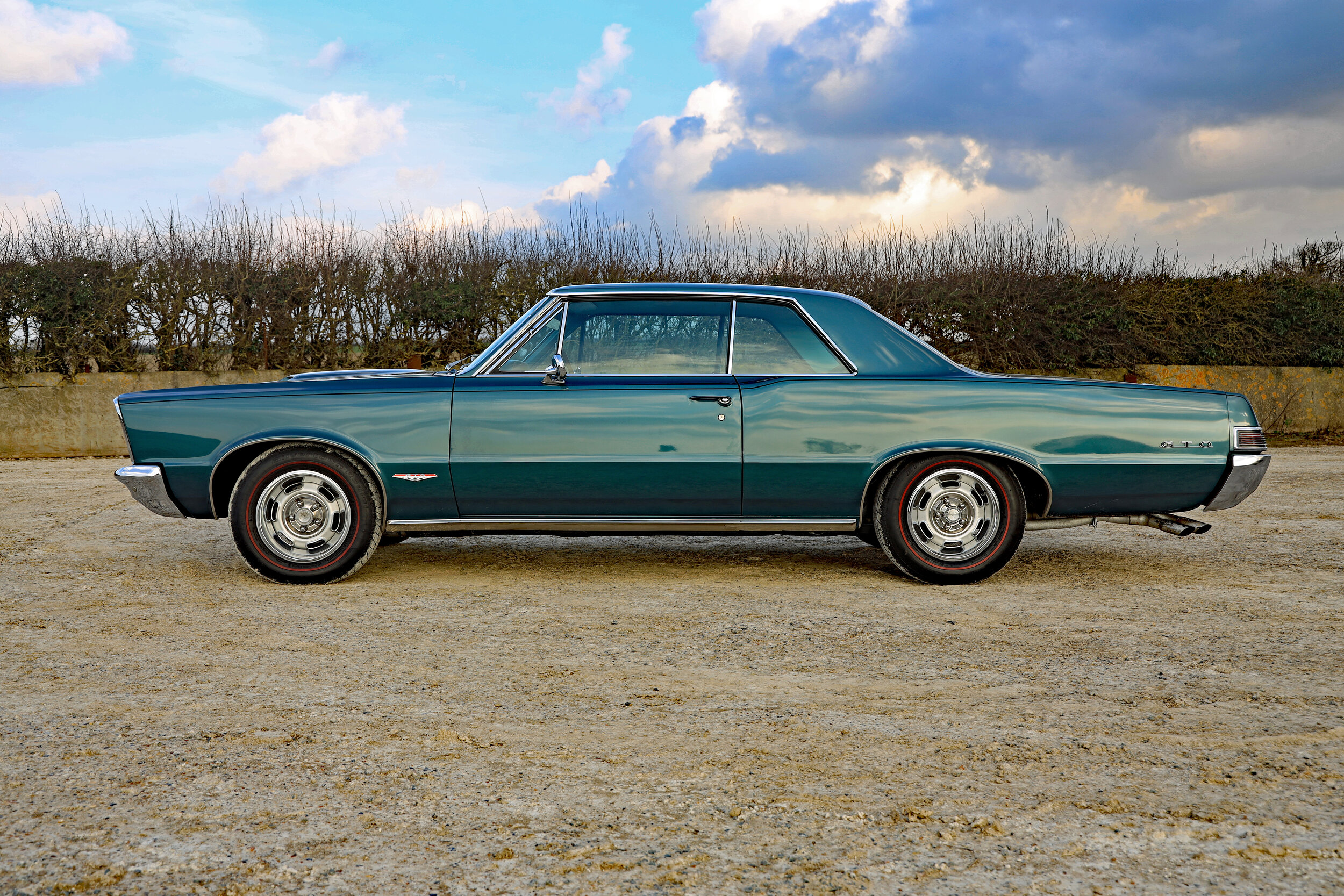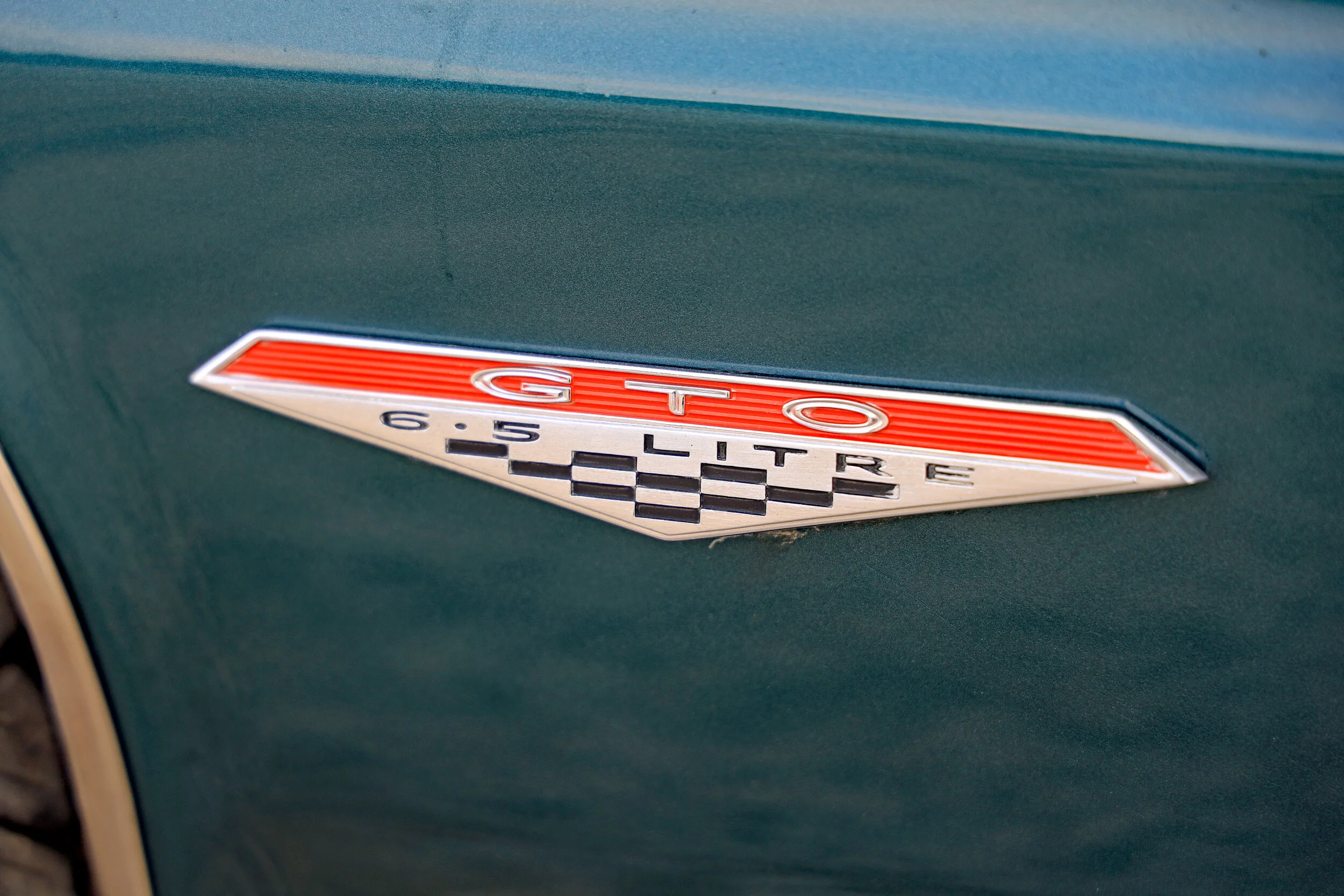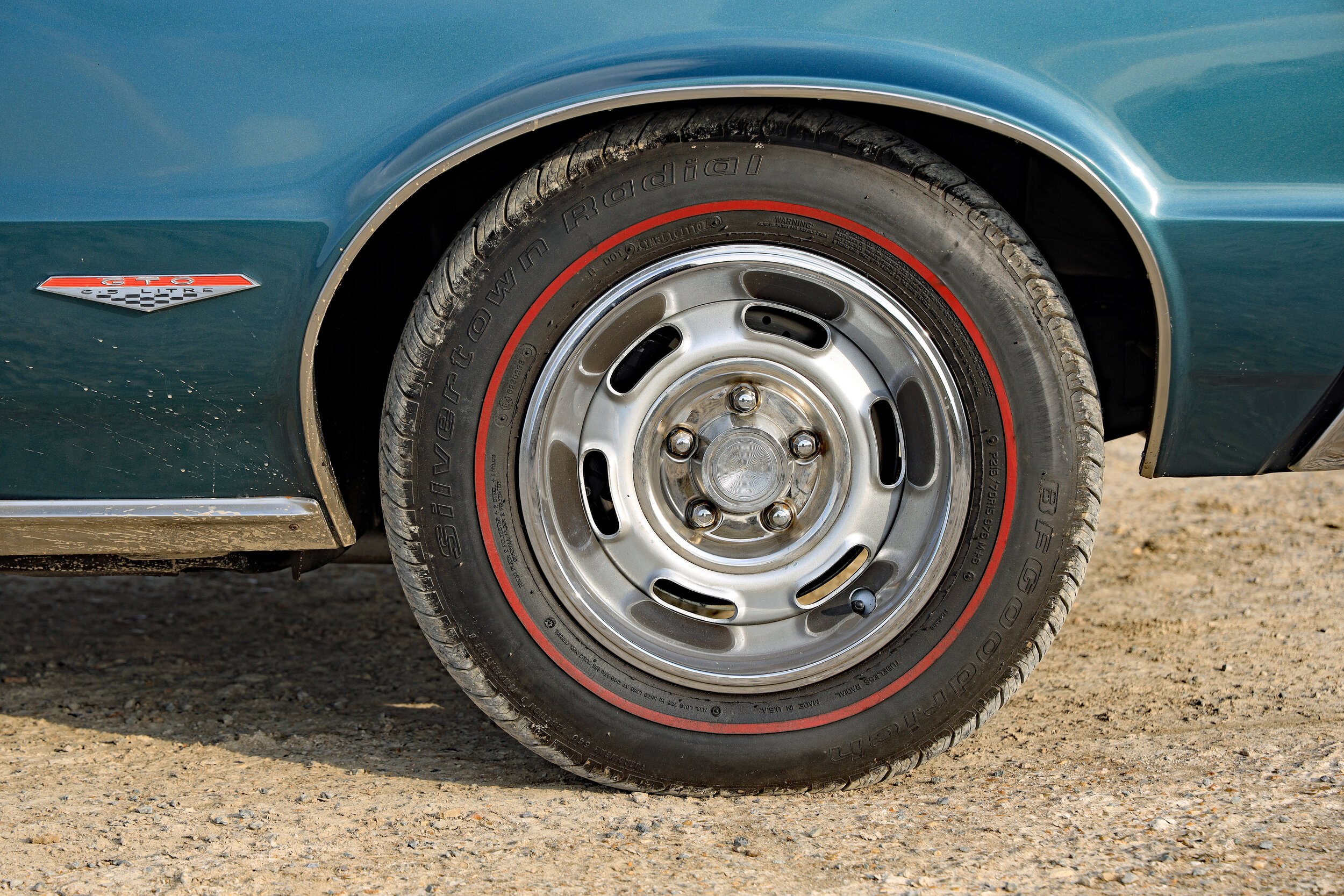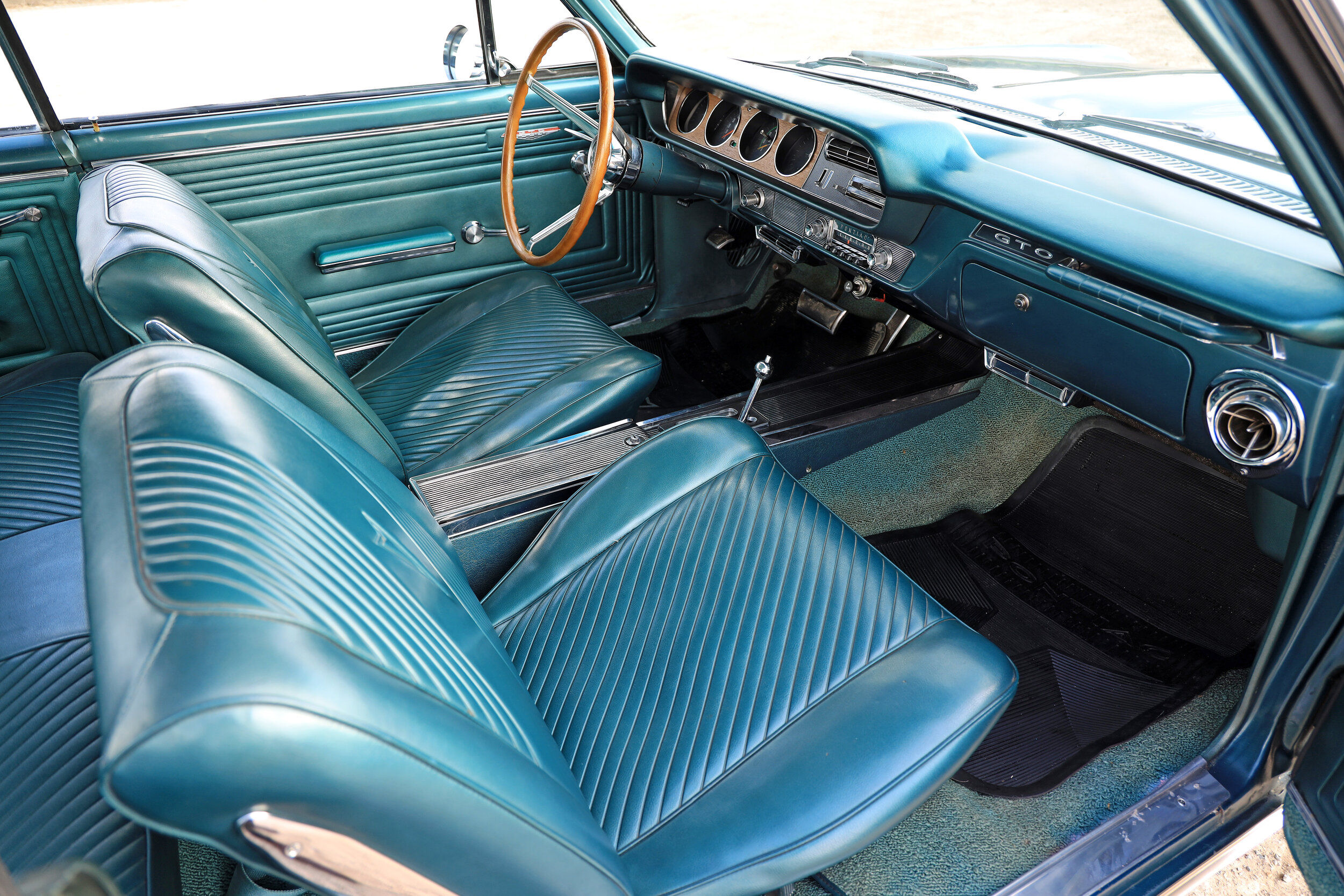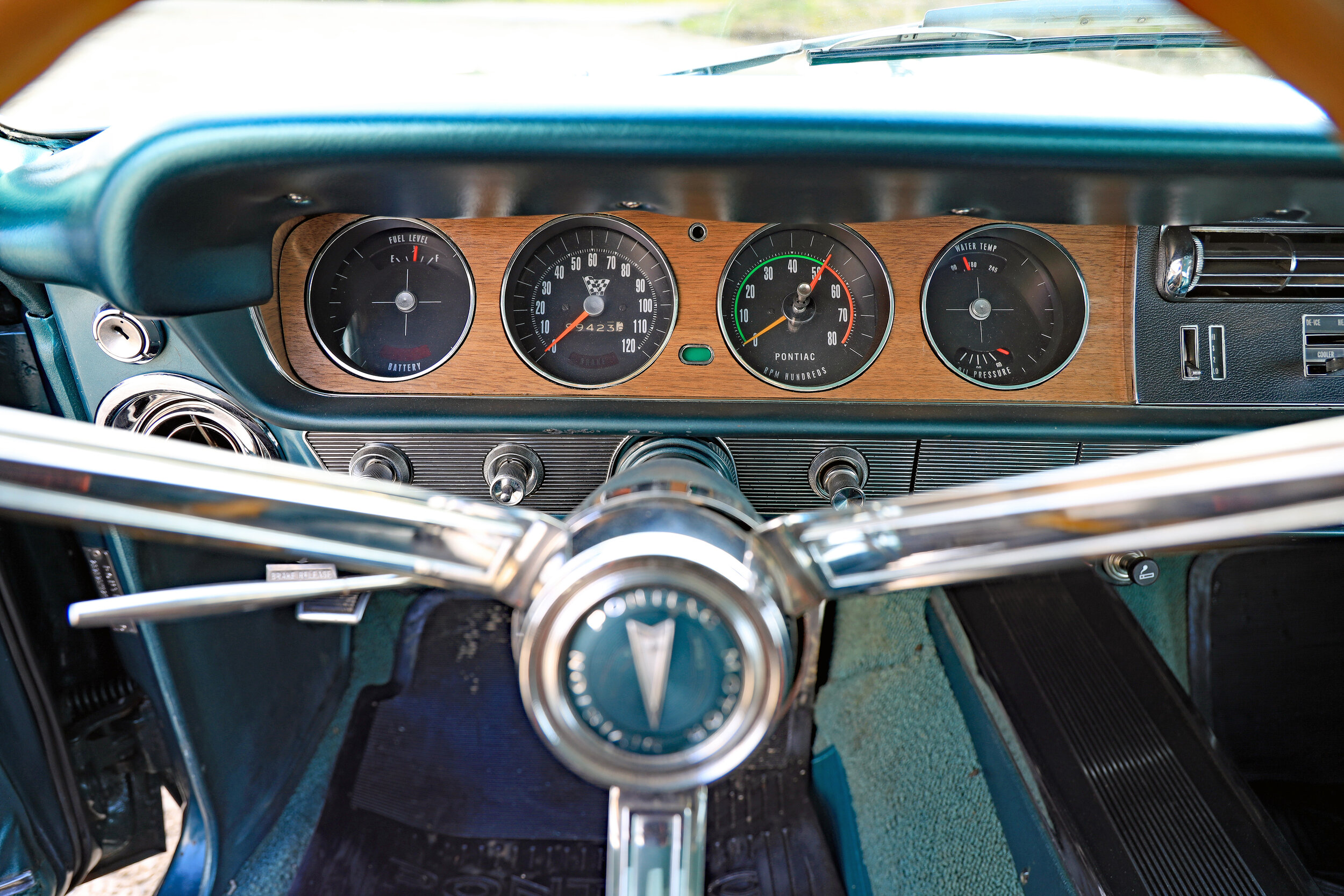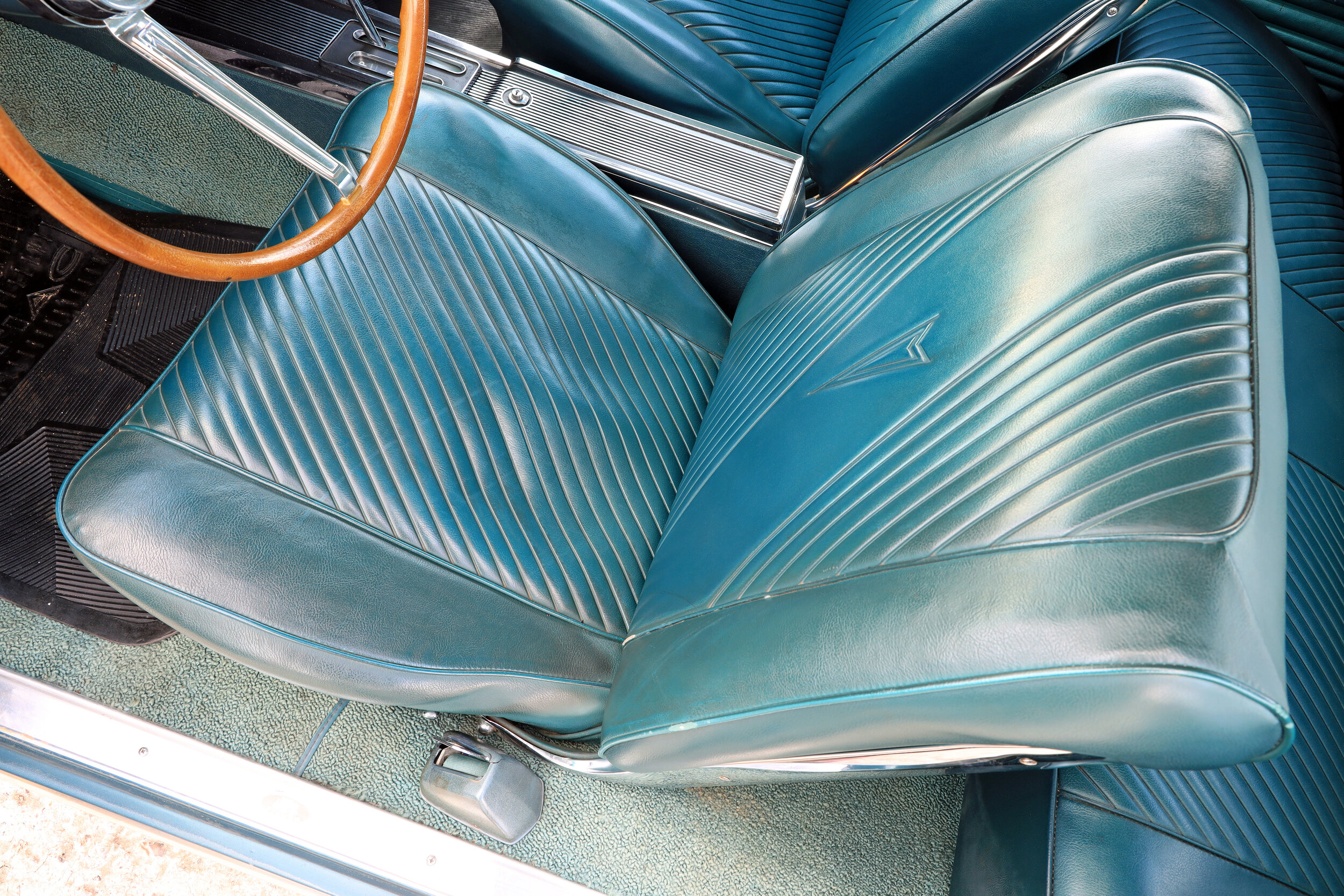1965 Pontiac GTO LeMans Hardtop Coupe
PRICE £SOLD
YEAR 1965
ENGINE 6375cc/V8/OHV/Carter AFB four-barrel carburettor
POWER 335bhp@5000rpm
TORQUE 431lb ft@3200rpm
MAXIMUM SPEED 125mph
0-60MPH 6.8sec
GEARBOX RWD, two-speed automatic
MILEAGE 99,423 miles
MOT 12 months from sale
CHASSIS NUMBER 237375K126944
COLOUR Reef Turquoise Poly
INTERIOR Turquoise
WIDTH 1890mm
LENGTH 5243mm
BACKGROUND
The original is often the best. And, when it comes to all American muscle cars, the original was the Pontiac GTO. The very potent, very powerful offshoot of Pontiac’s LeMans just oozed brooding machismo when it was launched in 1963. It led to the trend for dropping immensely mighty V8 engines into smaller cars - or at least, what Americans regarded as ‘smaller’ than their usual leviathans - to create high performance road machines. All the major US manufacturers soon followed Pontiac’s lead, resulting in the creation of a muscle car market, but the GTO was there first. It pre-dated even the Ford Mustang, and soon became an all-American legend.
The GTO came about because of General Motors’ decision to withdraw from motor racing in 1963. That left Pontiac, one of GM’s more performance-orientated divisions, at a little bit of a loose end. So, the marque switched its attention from marketing what its cars could do on the race track to trumpeting what they could do on the road instead. The GTO was the brainchild of John DeLorean (yes, that John DeLorean), Bill Collins and Russ Gee, and was conceived as a special high performance version of the Pontiac LeMans, which was itself an offshoot of the intermediate-sized Tempest. To create it, the 6.4-litre V8 from the large Catalina/Bonneville was shoehorned into the slightly more compact Tempest/LeMans body for 1964. With between 325bhp and 348bhp available, depending on which option boxes the customer checked, the GTO had far more oomph than its more conservative Tempest and LeMans siblings, plus a range of other cosmetic, mechanical and suspension upgrades - although the drum brakes remained the same as on the less powerful cars. The name was inspired by the Ferrari 250 GTO, which apparently upset Enzo Ferrari somewhat, but there was little he could do, especially as the counter claim was that GTO stood for ‘Grand Tempest Option’ rather than ‘Gran Turismo Omologato’. Besides, Enzo was invariably upset with anything that challenged Ferrari.
For 1965, there was a complete restyle, with a more square-rigged body and one of the most defining GTO features, the stacked headlamps. There was also more power - 335bhp to 360bhp - and a bonnet scoop. Although, fake news, it was actually a dummy intake that didn’t suck in air. But who cared? It looked superb; an instant reminder that this was no mere Tempest or LeMans.
The GTO became a model in its own right in 1966, adopting more curvaceous ‘Coke-bottle’ styling that year as well. In 1968, it was completely reworked into a second generation model, losing its stacked headlights in the process. The name was discontinued in 1974, but was briefly revived from 2003 to 2006. It’s the first generation models that are regarded as the best of the bunch though, especially in the form we have here - one from the very first year of the iconic vertical headlights. We are talking very, very desirable…
OUR CAR
This GTO was one of 54,805 389-4 cars built in 1965. And when you consider that Pontiac initially planned just 5000 GTOs as a limited edition run, it’s a measure of just how wildly successful the model was. Purchased from Luke Pontiac in Arlington, Texas - and still bearing the chrome boot badge proclaiming this - it stayed with its original owner until 2010. He used it as a second car and reputedly kept in a heated garage - as if one was actually needed in Texas. It underwent a full restoration in 2008, complete with an engine rebuild (and possibly an upgrade, as the registration document now lists the engine as 6.6 litres, rather than the 6.4 litres that was standard for a 1965 GTO).
The Texas renovation was to concours standards, but it seems that the first owner considered the car had lost some of its character with its revamp. So in 2010, he sold it on to a new owner in Maryland, who had the gauges renovated and sorted out the air conditioning. Then, in July 2012, it made the journey over the Atlantic to the UK. Mileage at the time was 97,912 miles. Since then, it’s only covered just over 1500 miles, in the hands of some quite prominent classic enthusiasts.
Its history file includes some documentation from its American life - showing that its cost in 1965 was $2556.00 for the basic LeMans Hardtop Coupé, but with the GTO package and other options taking the price up to $4026.78. There are photographs of the engine rebuild, as well as handwritten evidence of extensive work carried out in 2014, totalling several thousands. Even though, as a 1965 classic, there’s no need for an MoT, a new one will be put on prior to sale, for extra reassurance.
BODYWORK
When you stand in front of something as imposing and purposeful as this Pontiac, you can’t help but be reminded of the Ronny and the Daytonas’ 1964 debut hit, GTO. In it, John ‘Bucky’ Wilkin (aka Ronny) and his Daytona colleagues eloquently extolled the virtues of the performance Pontiac: “Little GTO, you’re really lookin’ fine…” And, my, this example really does look fine.
With Reef Turquoise Poly paint and sitting correctly on Red Band wheels, you can easily see why the GTO was such a dramatic entry into the American car market of the mid-1960s. It just radiates attitude and charisma. Although its restoration was in 2008, it has stood up very well to the passing of 13 years, helped of course by how few miles it has covered since then. There are a few age-related blemishes here and there, but very little of note. Even the aluminium trim only has a few random scratches that you really need to go up close to see. Those hefty chrome bumpers, and the trademark stacked lamps, are all excellent. While this GTO may not be in Texas any more, it’s weathering the British climate extremely well. There is no rust to be found. At the Pontiac’s last MoT, it sailed through the test first time.
All the badging for the Pontiac - including its ‘GTO 6.5-LITRE’ chequered flag side flashes (Pontiac just rounded the actual cubic capacity up a bit) and ‘LUKE ARLINGTON’ trunk branding - are in place. A dab of superglue on the connecting bar of the Luke logo wouldn’t go amiss, but that is as far as it goes with the need for any improvements to the exterior.
The tyres are GFGoodrich Silvertown Radial 215/70 R15 97S M+S items, with plenty of tread left on them despite the ability of the GTO for rubber-shredding high jinks. When the car was new, it would have been specified with Red Band tyres; that it still has the correct items 56 years after its birth is a testament to how faithful it has been kept. The rims they envelop are free from any issues.
“This little modified Pon-Pon has got plenty of style,” as that Ronny chap and his Daytona bandmates also noted in their song.
INTERIOR
The turquoise theme continues inside, with the vinyl seats, dashboard padding and carpets in the same shade. Everything is well-preserved; there are no tears or splits in the seats and the top of the dash, which often gets affected by hot sunlight through the windscreen, has no flaws. The carpets display some minor marking, but they’re covered by Pontiac-branded rubber mats. The doorcards are in superb order, with inserts echoing the ‘GTO 6.5-LITRE’ badging found on the exterior. ‘BODY by FISHER’ plaques, a reference to General Motors’ coachbuilding division, are in place on the sill step-plates.
The gauges are set into a light wood panel; the first dial (from left) records battery output and fuel level, the second is the 120mph speedometer, the third is the rev counter with manual limiter knob, and the fourth and final one registers the water temperature and oil pressure. Having been refurbished around a decade ago, all work as intended and give healthy readings. The timber is also in very good order, and matches the shade of the deep-dish steering wheel. All the electrics function as they should, and the addition of air conditioning is a handy extra feature to have.
The original Pontiac Delco car radio still occupies the centre of the dash, and what a lovely piece of 1960s’ audio art it is, with its chrome-fronted fascia. But for those maybe wanting their sounds to be a little more modern, there’s a 21st century CD/radio with removable front neatly installed in the glovebox.
The boot is cavernous, and protected by vinyl covers. Beneath those though, the metal is painted and free from any problems. The underneath of the bootlid has the original sticker attached detailing jack usage and stowage.
ENGINE AND RUNNING GEAR
Long as the bonnet - sorry, hood - may be on these cars, the big V8 still manages to fill up most of the available space. That said, unlike more modern engines, there’s good access for any maintenance. The engine and its bay are well-detailed and extremely clean, with glossy black-painted inner wings, a chromed air filter housing, and light metallic blue-painted engine block. All the wiring and pipework seems sound, with the fluids at the right levels and healthy in colour. The battery has a cut-off knob fitted on one terminal.
The engine fires up immediately when the key is turned and, oh, what a noise it makes. The noise of a deep bass American V8 in full voice is one of the great sounds of the automotive world. It just gets better when you head off. Despite the considerable amount of power, the automatic transmission makes just pottering around a simple proposition, but when the conditions allow, this GTO just takes off, with a guttural snarl that seems to reverberate for miles around. Of the many things this Pontiac may be, subtle it most definitely isn’t. Those who prefer their rides to be like mobile living rooms should look elsewhere, this is anything but laid back and lethargic. While American cars don’t always have the best reputation for handling, and this Pontiac GTO is admittedly no Ferrari GTO when it comes to road manners, it does give a good account of itself through twists and turns as well as on the straights where its you can properly unleash its 335bhp. However, just remember the brakes are drums, and while they’re effective enough under most circumstances, they don’t have quite the same bite as modern discs.
SUMMARY
When it comes to muscle cars, the Pontiac GTO is one of the premier league. And this example is one of the better ones available, in our opinion. These cars aren’t that plentiful on this side of the Atlantic, and there can’t be that many in this kind of all-round very good condition. It’s thoroughly sorted inside and out. If you want to appreciate just why Ronny and the Daytonas were so besotted with these, ahem, ‘little’ GTOs, this could well be the car that makes you “the coolest thing around”.
Whilst Greenside Cars Ltd has tried to ensure information and assessments are accurate and complete, we are aware that some errors and omissions may occur from time to time. We are not able, therefore, to guarantee the accuracy of information and cannot accept liability for loss or damage arising from it. We highly recommend that you examine any vehicle to check the reliability of the information supplied. Please contact us for further details, images, or to arrange a viewing of this Pontiac GTO LeMans Hardtop Coupé.
Those trademark stacked headlamps are in excellent order, as is the chrome of the extensive bumper underneath.
One of the best period items on the GTO is its original dealer badging on the boot, having been sold by Luke Pontiac in Arlington, Texas.
Air conditioning is fitted, with the Frigidaire unit prominently underneath the GTO’s substantial bonnet.
A modern ‘face-off’ CD/radio is cunningly concealed in the glovebox, while the original Delco transistor unit occupies the main slot in the centre of the dashboard.
